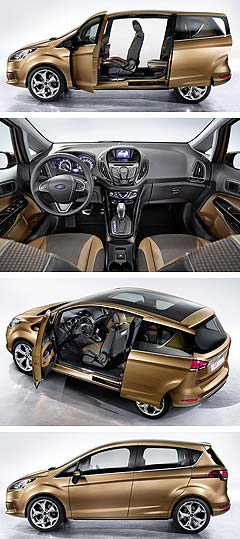Geneva show: Ford maxes out Fiesta
BY MARTON PETTENDY | 1st Mar 2011

Designed as a direct rival for the Opel Meriva MPV from General Motors in Europe, the B-segment people-carrier will slot underneath Ford’s Focus-based C-Max MPV.
The headline act of Ford’s all-new light-sized wagon, which is based on the same global platform as the Fiesta and Mazda2 hatch and sedan, is a new production-ready twin rear sliding door system that does away with traditional B-pillars.
As such, Ford claims the B-Max delivers best-in-class front and rear seat access, unmatched convenience and flexibility, and the comfort and luxury of a much larger vehicle.
Equally significant is the B-Max’s new 1.0-litre three-cylinder EcoBoost petrol engine, which is designed to replace larger four-cylinder petrol engines and is currently undergoing final development testing before going into production.
Although no performance or efficiency details have been revealed, Ford claims the newest EcoBoost engine returns “ultra-low” CO2 emissions when fitted with its Auto-Start-Stop idle-stop system.

Wrapped in the latest interpretation of Ford’s ‘kinetic’ exterior design language and based loosely on the Iosis Max concept from the 2009 Geneva show, the B-Max is 110mm longer and taller than the Fiesta five-door and 320mm shorter than the C-Max at just over four metres in length.
Closely resembling Ford’s large S-Max people-mover, the B-Max adds a new take on the Blue Oval’s signature trapezoidal grille, distinctive headlight graphics, a muscular shoulder line, a new rocker treatment, a window line that kicks up behind the rear doors, prominent wheelarches and three-dimensional body surfacing to avoid the traditional slab-sided people-mover look, as well as a zig-zag feature on the rear doors.
Ford says the B-Max’s B-pillarless twin rear sliding doors offer an opening aperture more than 1.5 metres wide – more than double that of any competitor with an alternative door concept – significantly improving entry and exit, loading of luggage or shopping, and general practicality, including attending to children.
With the 60/40-split rear seats and front passenger seat folded, which creates a large flat load space and the ability to cart loads up to 2.35 metres long, Ford says the B-Max will also more easily swallow bulky cargo like flat-pack furniture or a bike.
The B-Max’s integrated B-pillar body design is said to deliver the same level of crash protection as traditional people-movers by comprising significantly strengthened front and rear door structures, which feature ultra-high-strength Boron steel in key load-absorbing areas to absorb energy like a “virtual B-pillar”.
Like the C-Max, the B-Max cabin comes with driver controls from Ford’s Human Machine Interface (HMI) parts bin, as well as a large six-inch touch-screen mounted in the centre of the dashboard above the mobile phone-style centre stack.
There is also a full-size panoramic glass roof for the B-Max, which will replace Ford’s aged Fusion crossover in Europe.
However, Europe’s new B-Max is not to be confused with a second B-segment people-mover or SUV Ford is believed to be developing from the previous-generation Fiesta platform for emerging markets, just like the Ford Australia-designed Figo – a car that appears to have more chance of coming to Australia than the B-Max.
“The B-Max demonstrates Ford’s commitment to providing customers with exciting and innovative vehicles,” said Ford of Europe chairman and CEO Stephen Odell.
“We believe that the new concepts and technologies it showcases will have a major impact on the small car market.
“With its highly popular S-Max and Galaxy, and more recently the all-new C-Max and Grand C-Max, Ford has a proven history of bringing innovation and style to the multi-activity vehicle market. The new B-Max signals that Ford is ready to bring the same bold thinking to the small car market.
“With its unique door format and dynamic design, the B-Max sends a strong message that customers looking for a compact, stylish and versatile vehicle will soon have an exciting new choice.”Appearing alongside the B-Max in Geneva will be the super-frugal new Mondeo Econetic variant, which makes its world debut alongside European debuts of the all-electric Transit Connect van and Focus Electric, and the C-Max Energi plug-in hybrid from this year’s Detroit show, where Ford committed to five hybrid or fully-electric vehicles by 2013.
Ford will also display its 2011 Fiesta RS World Rally Championship contender and a ‘New Metal’ variant of its Fiat 500-based Ka city-car, showcasing a new set of personalisation options under the Ford Individual banner.